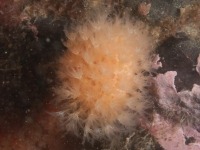
(Photo: Claire Goodwin)
Dead man's fingers
Alcyonium siderium
An orange soft coral. Colonies may be single lobes or branched. They can be up to 15 cm tall. Their feathery polyps may be visible or can be retracted.
Authority
Verrill, 1922
Classification Details
Phylum: Cnidaria (Cnidarians); Class: Anthozoa (sea anemones, corals, and sea fans); Subclass: Octocorallia (octocorals); Order: Alcyonacea (soft corals).
Habitat
Colonies grow on shallow bedrock in the Gulf of Maine. Can form dense groups of hundreds of colonies. Due to the crawling larvae, this species has a short dispersal range. It can have dense populations on one rock wall where another close by wall lacks it entirely.
Diet
Suspension feeder, feeding on zooplankton. Each polyp in the colony has eight tentacles at its end, with delicate branches to catch plankton in the water. Prey is stunned by stinging cells (nematocysts) that are on the tentacles. Unlike many other corals, Alcyonium do not have the symbiotic photosynthesizing organisms called zooxanthellae.
Reproduction
Colonies are hermaphroditic (both male and female) but it is not known whether they can self fertilize. They produce gonads between January and July each year. Fertilization takes place in June or July. Larvae are brooded inside parent colonies until they reach a crawling planula stage. They are released in August and settle within a few days. Only 5-25% of juveniles survive their first year. Colonies that do survive can live for several years.
Fun Facts
This species must compete with other filter feeders for space on its bedrock habitat. Sea squirts are one of its competitors, but it reduces their numbers by eating their larvae before they can settle.
Colonies are taller in areas where there is more water movement. Water movement brings more zooplankton to the colonies. This allows them to capture more food and grow faster.
References
Sebens KP (1983) The larval and juvenile ecology of the temperate octocoral Alcyonium siderium Verrill. I. Substratum selection by Benthic larvae. Journal of Experimental Marine Biololgy and Ecology 71:73–89.
Sebens KP (1983) The larval and juvenile ecology of the temperate octocoral Alcyonium siderium Verrill. II. Fecundity, survival and juvenile growth. Journal of Experimental Marine Biololgy and Ecology 72:263–285
Sebens KP (1984) Water flow and colony size: Interhabitat comparisons of the octocoral Alcyonium siderium. Proceedings of the National Academy of Science USA 81: 5473–77
Verseveldt J (1973) On the validity of Alcyonium siderium Verrill (Colenterata: Octocorallia). Zoologische Mededelingen 46: 209–216


